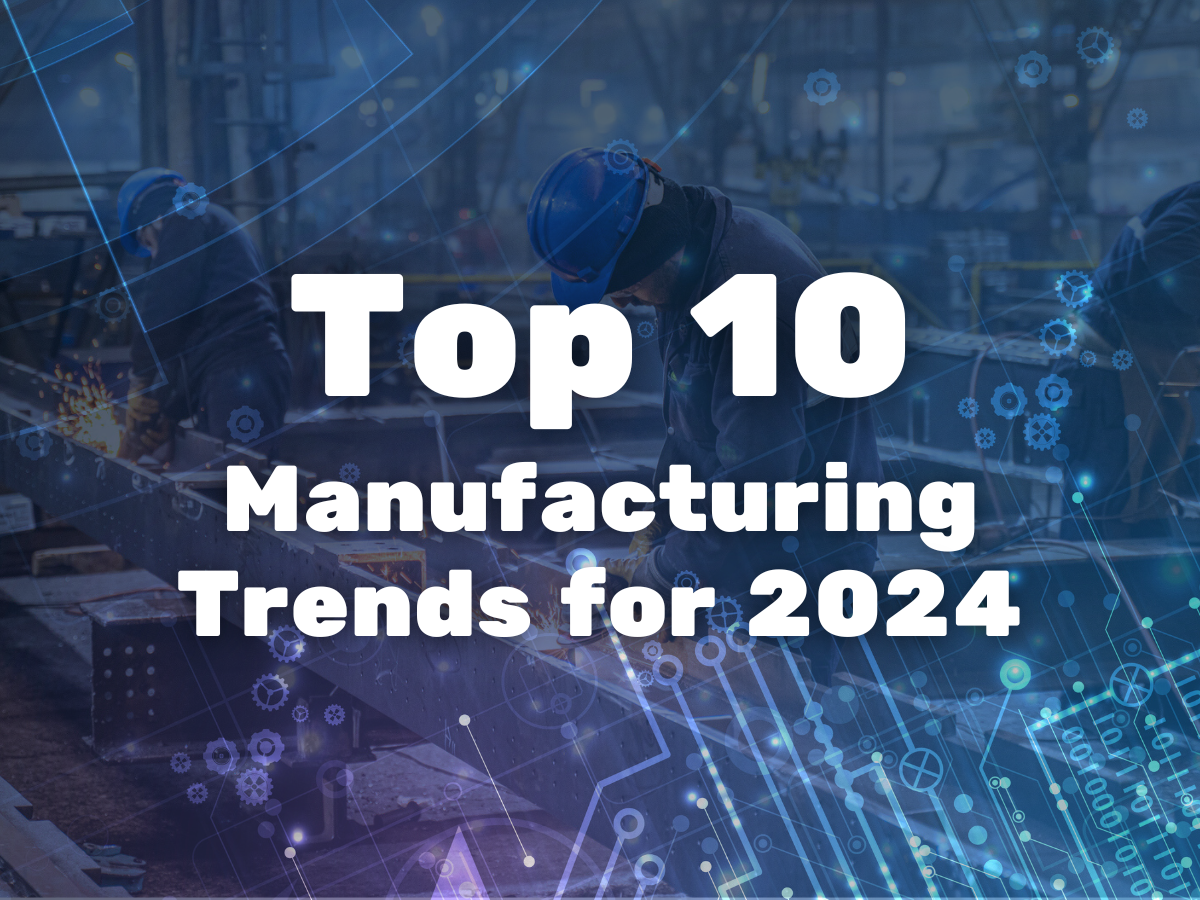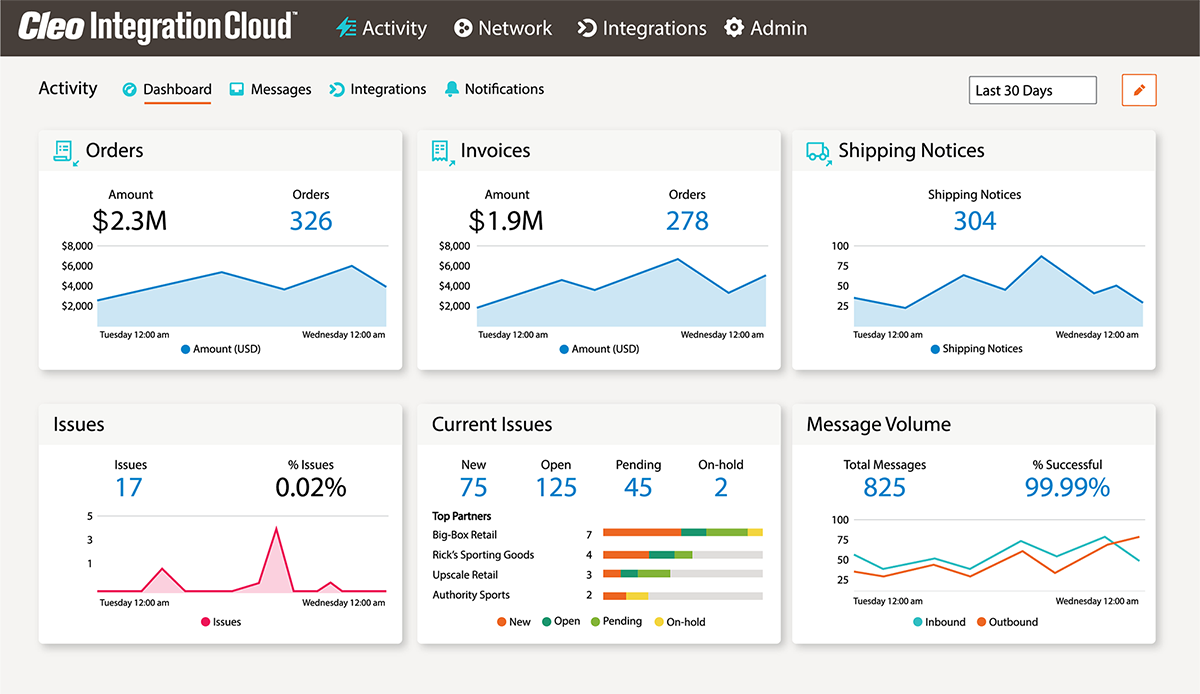Top 10 Manufacturing Trends for 2024

In 2023, the manufacturing industry was largely in contraction. This was due to persistent challenges regarding consumer demand, labor shortages, continued supply chain disruptions, net-zero emission targets, and the demand for innovation.
To turn things around in 2024, manufacturers will need to tackle these risks by improving processes with the help of new technologies. This requires bold leadership and willingness to adopt innovations in the space. Below are 10 trends that will shape manufacturing in 2024, which we dive into greater depth:
Top 10 Manufacturing Trends
1. Less B2B, More B2C
2. Automation in Artificial Intelligence-Evolving Employment Positions
3. The Wave of Onshoring
4. Continued Battles Against Supply Chain Disruptions
5. Greater Progress Towards Smart Factories
6. Reassessments in Supply Chain Efficiency
7. Enhancing Margins Through Data-Driven Decisions
8. Greater Progress Toward Carbon Neutrality
9. 3D Printing Rewrites Innovation
10. Market Competition Fueling Ecosystem Collaboration
Trend 1) Less B2B, More B2C
To sell their products to consumers, manufacturers historically had to use either a distributor who would then sell their products to wholesalers, resellers, and retailers, or manufacturers could sell to retailers. Through the rise of technology though, manufacturers can now sell their products directly to consumers and are actively deploying this model.
A primary example of how this is done is via eCommerce platforms and marketplaces. With the rise in popularity of online shopping, manufacturers are taking advantage of this direct access to consumers and can cut out the cost of utilizing a middleman.
There are additional benefits for manufacturers that pursue B2C. Manufacturers can interact and engage directly with their consumers, they can collect key data on their customers’ shopping habits, gather direct feedback on products and services, possess more governance over branding, and better control pricing.
Trend 2) Automation in Artificial Intelligence-Evolving Employment Positions
While automation in manufacturing is nothing new, organizations are leveraging robotics more than ever to manage operations, decrease costs, and maintain their position in the market. As a result, the global industrial robotics market is expected to expand at a compound annual growth rate (CAGR) of 10.5% between 2023 to 2030. Analysts expect the growth will be largely driven by the companies shifting to in-house manufacturing to avoid future global supply chain issues.
Robotics has come to the rescue of other sectors, like agricultural manufacturing, which struggled to fill the labor gap. For example, robotics enabled produce growers to complete planting and harvesting when travel restrictions and border closures decimated their labor supply. Other companies have invested in “cobots” to work side-by-side with human employees when they couldn’t attract additional labor.
But while robotics can dramatically improve how companies operate, they continue to spark concerns about the potential negative impact on the workforce. As companies reevaluate how to best use their human capital, we expect them to focus on upskilling employees to take on duties requiring more collaboration and communication — skills robots are less likely to master (at least anytime soon).
Trend 3) Onshoring
After years of companies offshoring labor to foreign countries, the tide is starting to shift. In 2023 alone, 76% of manufacturing CEOs successfully reshored some or all of their operations. This is largely due to several reasons.
Faster Delivery
Consumers expect their products faster. By offshoring manufacturing to countries far away from where a manufacturer’s customers live, it takes a much longer time for customers to receive their orders.
Less Supply Chain Disruptions
Onshoring minimizes dependencies on foreign suppliers which helps reduce supply chain disruptions caused by international conflict, taxes and tariffs, inclement weather, and more.
Reducing Environmental Footprint
Onshoring means less pollution and greenhouse emissions that are caused by shipping orders. And as companies, consumers, and government officials care more about sustainability more than ever, reducing greenhouse emissions is a priority for companies across nearly every industry.
Improved Quality Assurance
By bringing operations back onshore, companies can be more confident in their quality assurance efforts since they can check the products for themselves. They no longer have to rely on third-party quality assurance providers to assess their products for them.

Conquer Manufacturing Integration Challenges
Move and transform any data to seamlessly integrate with any partner and application. Dive deeper and learn how our solution can transform your operations.
Trend 4) Continued Battles Against Supply Chain Disruptions
After years of supply chain disruptions, analysts projected supply chains would be back to normal by now. Instead, according to Cleo’s 2024 Ecosystem Integration Global Market Report, 41% of respondents said their company did not meet 2023 business objectives due to supply chain disruptions.
Unfortunately, it appears disruptions will continue well into and beyond 2024. For instance, global supply chains are already facing challenges in 2024 as disruptions at two of the world’s busiest trade corridors are ongoing—the Panama Canal and the Suez Canal.
The supply chain is vulnerable to other factors as well, such as catastrophic weather events and geopolitical unrest. Examples include the 2023 Canadian wildfires and the flooding in California, the wars between Russia and Ukraine, as well as Israel and Hamas, and worker strikes.
Trend 5) Greater Progress Towards Smart Factories
Manufacturers will continue to invest in technology to become smart factories, with 83% of manufacturers claiming that smart factory solutions will transform the way products are made in five years. Here are the technologies leading the transformation:
- Sensors: Placed on machines and devices to track and monitor processes. For instance, they can monitor machine temperature levels and self-correct or alert operators when a problem arises. When connected to a network, sensors can be used to monitor more than one machine at a time.
- Cloud Computing: A more flexible, less expensive way to manage the data that sensors collect. The cloud makes it possible to upload, store, and evaluate data in real-time to support agile, strategic decision-making.
- Big Data Analytics: Provides insights into production process performance, identifying error patterns and more accurate predictive quality assurance. Different factories and organizations can share the data to solve common problems and further enhance processes.
- Virtual and Augmented Reality: Allows companies to create visual simulations of manufacturing processes and environments to support and improve operational processes, product development, and training programs. For example, VR technology makes it possible to design, test, and create prototypes of new products in a virtual environment.
- Digital Twins: Provides a virtual replica of a physical object or process to simulate performance in the real world under varying conditions and circumstances. For example, creating a digital twin for a wind turbine (based on data collected from sensors on a physical turbine) allows an energy company to project how a turbine will function and perform in the environment it’s placed in.
Trend 6) Reassessments in Supply Chain Efficiency
The 2020 worldwide supply chain disruption impacted 95% of all supply chains and demonstrated the limitations and drawbacks of traditional operations or business-as-usual approaches. As a result, manufacturers have been reassessing every aspect of the production process and are accelerating the adoption of new technology and software for procurement, inventory, assembly, logistics, transportation, and sales. The inventory management software market alone, valued at $1.53 billion in 2021, is expected to reach $2.56 billion by 2029.
However, digitizing and optimizing the entire supply chain remains the overriding goal, enabling companies to improve efficiency, the ability to react quickly when disruptions do occur, and predict production and inventory changes in near real-time. While the shift to digital isn’t new, companies are continuing to further integrate new technologies into their processes and operations.
Trend 7) Enhancing Margins Through Data-Driven Decisions
Downtime in manufacturing is widespread and can have a crippling impact on the bottom line. For example, one study found that Fortune Global 500 companies lost 11% of annual revenues due to downtime in 2023. Moreso, it was determined that businesses lose $260k per hour from downtime, with downtime occurring weekly for 60% of companies.
As a result, ensuring all equipment functions at optimal performance levels is critical. Manufacturers continue to shift away from traditional time or usage-based maintenance practices in favor of predictive maintenance tools and technologies to catch issues before production is impacted.
Through a combination of IoT, AI, and machine learning, it enables a proactive, data-driven approach to reveal important trends that enable operators to make better decisions. More companies will embrace this proven approach in the coming years to boost ROI, improve output, eliminate unplanned downtime, and reduce machine failures.
Trend 8) Greater Progress Toward Carbon Neutrality
As the third largest contributor to greenhouse gas emissions, reducing the carbon footprint across the supply chain has become an urgent priority for the manufacturing industry. Regulations and government investment have fueled significant progress toward sustainability by requiring manufacturers to transform end-to-end operations to low-carbon or carbon-neutral systems.
In addition, manufacturers’ customers are imposing stringent environmental, social, and governance (ESG) requirements of their own, further motivating manufacturers to rethink past ways of doing business and how they manage relationships with trading partners.
As manufacturers prioritize sustainability as Accenture’s recent study indicates, we can expect digitalization to be at the top. It found that accelerated digitalization in German manufacturing would represent more than 50% of total CO2 reduction efforts.
Trend 9) 3D Printing Rewrites Innovation
3D printing has opened up numerous opportunities for consumers and enterprises alike. For manufacturers, this technology will enable them to be more agile while also saving money.
As an example, 3D printing enables rapid prototyping so products can reach shelves faster, speeding time-to-revenue. Additionally, 3D printing will be beneficial regarding maintenance and repairs in factories. So when a factory machine breaks in the assembly line, instead of having to source and order hard-to-find parts, or place an order for a custom part, manufacturers can create their own part in-house. This helps manufacturers decrease supply chain disruptions and increase uptime.
Lastly, technology is allowing for greater innovation that can reduce a company’s environmental impact and cut costs. Traditional manufacturing tends to create a lot of excess when creating and testing new products, as well as custom parts. 3D printing on the other hand, only uses the amount of material needed to create a specific product or part.
Trend 10) Market Competition Fueling Ecosystem Collaboration
Staying competitive in the manufacturing industry requires a renewed focus on strengthening relationships. Through closer collaboration and integration with customers, partners, and suppliers, companies can detect and respond to disruptions, changing market conditions, or customer needs more effectively and quickly.
Over the past few years, it was revealed that many supply chains lacked basic communications or digital connectivity to support internal collaboration, let alone communication with essential stakeholders.
As a result, manufacturers are adopting ecosystem integration solutions to create collaborative work environments and generate shared value opportunities. In addition, manufacturers are positioning themselves for long-term success with access to foundational network visualization and mapping tools that facilitate real-time data sharing across connected systems, platforms, trading partners, and more.

See Our Platform in Action
Watch a quick demo to learn how you can automate EDI & API, onboard parters faster, and directly integrate into any ERP/TMS/WMS.
Addressing and Capitalizing on These Manufacturing Trends
Like all businesses, manufacturers have become multifaceted ecosystems of suppliers, partners, systems, applications, distributors, and more. Sky-high customer expectations, economic uncertainty, and evolving production methods add further complexity. It’s clear that a fresh approach to integration — one that delivers control and agility — is needed to solve today's end-to-end supply chain challenges.
Cleo’s Integration Cloud (CIC) delivers, consolidating manufacturing API, EDI, and file-based integration technology into a single platform. It allows manufacturing companies to leverage the cloud to connect data and B2B systems across all suppliers and distributors and with their internal backend ERP, TMS, or WMS systems. Here’s what our customers can do as a result of implementing the CIC:
- Accelerate onboarding of partners and applications for 4x faster time to revenue
- Improve customer satisfaction by delivering on performance expectations through greater visibility into SLAs
- Consolidate transaction silos under one real-time view
- Meet any integration requirement over multiple communication protocols, including AS2, SFTP, and more
- Assess the health of EDI integrations and pinpoint and respond to issues immediately
- Gain the benefit of EDI, API, and flat-file integration on a single platform
- Enjoy the choice of self-service, managed service, or a blended deployment approach
Ready to learn more about how the Cleo Integration Cloud platform combines the best of traditional and modern cloud integration services into a single ecosystem integration platform? Check out our demo video for manufacturing and get in touch.
Find out more about how manufacturing companies are modernizing their integration with a Manufacturing Solution Brief.

About Cleo
